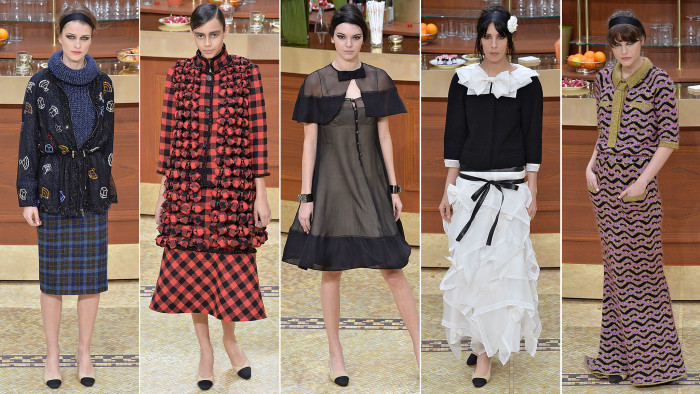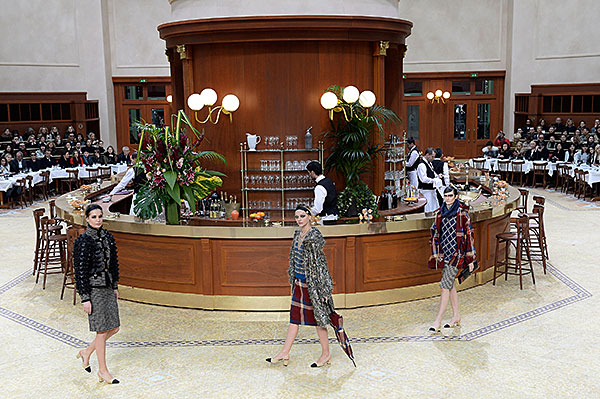Chanel — Paris Fashion Week AW15 show report

Simply sign up to the Life & Arts myFT Digest -- delivered directly to your inbox.
Last season, Karl Lagerfeld staged a feminist protest. Then, in January, in the wake of the Charlie Hebdo massacre, came the biggest public demonstration yet seen in France, for which almost a million people congregated in Paris in a statement of solidarity.
Lagerfeld’s demonstration infuriated as many as it inspired but one could argue that his fashion rally in September did pre-shadow a period of old-fashioned French activism. This past weekend Parisians paraded again, demanding an end to sexual violence in support of International Women’s Day. “Watching it on television, I thought I was watching my SS15 show”, observed the designer mischievously after presenting his AW15 collection.
Last season’s liberation, Lagerfeld argued, had “freed women up to go and enjoy themselves”. And where would we go to do that? The Chanel Brasserie, naturally — the temporary restaurant Lagerfeld had erected at the Grand Palais and in which the lucky patrons might snatch a little café, or even a boiled egg, before the show.
From the velvet banquette seating, to the gilt-rimmed central coffee bar and dome lights, the set represented the most French of clichés; one that Lagerfeld, as a self-confessed “stranger” in France, had mounted as a corrective to “French bashing”, celebrating the snooty, bourgeois, stylish smugness that we all love to hate.
There were a few exceptions. The glass-polishing waiters, for example, were actually smiling. What craziness was this? “Maybe French waiters don’t smile usually because the tips aren’t good,” suggested Lagerfeld from behind a large central bar where he was playing temporary barista post-show. “We’re not in America here. Maybe they don’t smile usually because they’re not very cheerful.”
All context aside, Lagerfeld’s collection for Chanel AW15 was resolutely practical: gentle roll-necks, and mosaic-tiled apron skirts that reflected the floor design and were made for “sitting down in”, quilted floral coats, pretty tweeds and embroidered parkas in lieu of evening coats. “People don’t wear evening coats any more,” he explained of the collection’s leisurely emphasis. Hence, with the parka, he had simply elevated a daywear staple and refashioned it in richer, more luxurious materials. “I want the ready-to-wear clothes to work in the context they are designed for,” he shrugged. “These are clothes in which to go and have some lunch.”

With their neat ribbon headbands, mussy chignons held with Chanel hair slides (the house’s hair accessories are the absolute best) and sensible skirt lengths, these ladies who lunched were a very chic breed. Lagerfeld had found the key to this silhouette in a simple, square block-heeled monochrome slingback that was worn with every look. The oldest Chanel shoe in the archive, and the chosen footwear of Mademoiselle Coco herself, the designer hadn’t touched it before despite a now 32-year tenure at the house. “I had never used it, I thought it was the worst,” he explained of its journey to super-accessory status here. “But then we were trying the clothes with different shoes, a stiletto and a boot . . . and everything looked dated.”
A quick dust-off and redesign later, Lagerfeld unlocked his collection. “It all made sense,” he continued of the shoe. “It was very French, very modern: it is the new bourgeois. It makes a nice leg and it goes with every length.”
It’s also extremely walkable in. Just what one might need when we next take to the streets.
Photographs: Catwalking.com
For more reports from the Paris shows, visit our fashion weeks page on the FT web app or our AW2015 fashion weeks hub on FT.com
——————————————-
Letter in response to this article:
Have designers run out of outrageous ideas? / From Siobhan Robertson
Comments